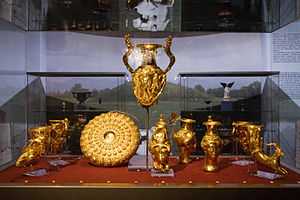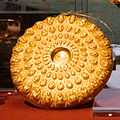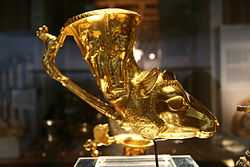Panagyurishte Treasure
 | |
| Material | gold |
|---|---|
| Created | 400 BC – 300 BC |
| Discovered | 1949 at Panagyurishte |
| Present location | Plovdiv Regional Archaeological Museum |
The Panagyurishte Treasure (Bulgarian: Панагюрско златно съкровище) is a Thracian treasure excavated on December 8, 1949 by three brothers, Pavel, Petko and Michail Deikov who worked together at the region of “Merul” tile factory near the town of Panagyurishte, Bulgaria. It consists of a phiale, an amphora and seven rhytons with total weight of 6.164 kg of 24-karat gold. All of the objects are richly and skilfully decorated with scenes of Thracian myths, customs and life. It is dated from the 4th-3rd centuries BC, and is thought to have been used as a royal ceremonial set by the Thracian king Seuthes III. As one of the best known surviving artifacts of Thracian culture, the treasure has been displayed at various museums around the world. When not on a tour, the treasure is the centerpiece of the Thracian art collection of the National Museum of History in Sofia.
The items may have been buried to hide them during 4th century BC invasions of the area by the Celts or Macedonians. The phiale carries inscriptions giving its weight in Greek drachmae and Persian darics.
Gallery
See also
References
External links
| Wikimedia Commons has media related to Panagyurishte treasure. |
.jpg)


